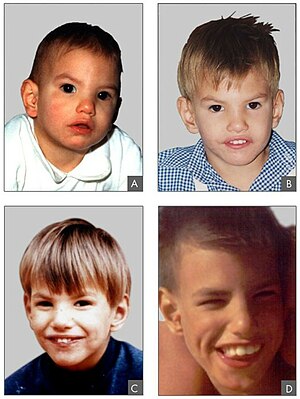Cri du chat syndrome
| Cri du chat or Cri-du-chat | |
|---|---|
 |
|
| Facial features of a patient with Cri du Chat syndrome at age of 8 months (A), 2 years (B), 4 years (C) and 9 years (D) | |
| Classification and external resources | |
| Specialty | Medical genetics |
| ICD-10 | Q93.4 |
| ICD-9-CM | 758.31 |
| OMIM | 123450 |
| DiseasesDB | 29133 |
| MedlinePlus | 001593 |
| eMedicine | ped/504 |
| Patient UK | Cri du chat |
| MeSH | D003410 |
| Orphanet | 281 |
Cri du chat syndrome, also known as chromosome 5p deletion syndrome, 5p− (said minus) syndrome or Lejeune’s syndrome, is a rare genetic disorder due to chromosome deletion on chromosome 5. Its name is a French term (cat-cry or call of the cat) referring to the characteristic cat-like cry of affected children. It was first described by Jérôme Lejeune in 1963. The condition affects an estimated 1 in 50,000 live births across all ethnicities and is more common in females by a 4:3 ratio.
The syndrome gets its name from the characteristic cry of affected infants, which is similar to that of a meowing kitten, due to problems with the larynx and nervous system. About 1/3 of children lose the cry by age of 2 years. Other symptoms of cri du chat syndrome may include:
Other common findings include hypotonia, microcephaly, growth retardation, a round face with full cheeks, hypertelorism, epicanthal folds, down-slanting palpebral fissures, strabismus, flat nasal bridge, down-turned mouth, micrognathia, low-set ears, short fingers, single palmar creases, and cardiac defects (e.g., ventricular septal defect [VSD], atrial septal defect [ASD], patent ductus arteriosus [PDA], tetralogy of Fallot). Infertility is not associated with Cri du chat.
It has also been observed that people with the condition have difficulties communicating. While levels of proficiency can range from a few words to short sentences, it is often recommended by medical professionals for the child to undergo some sort of speech therapy/aid with the help of a professional.
...
Wikipedia
